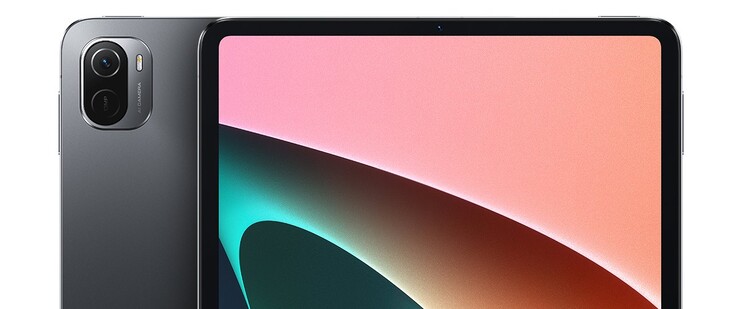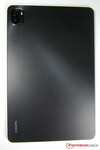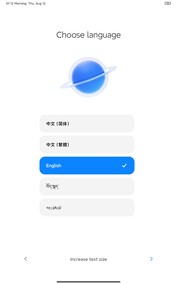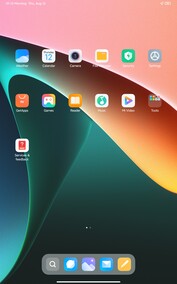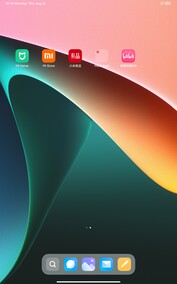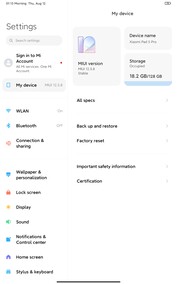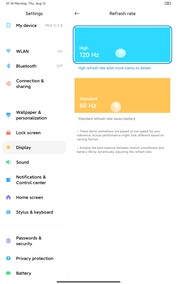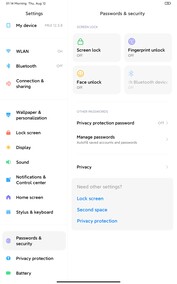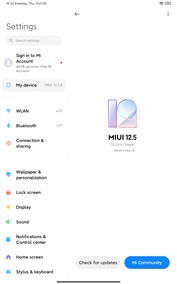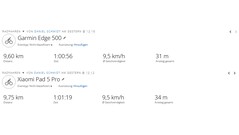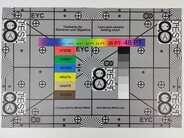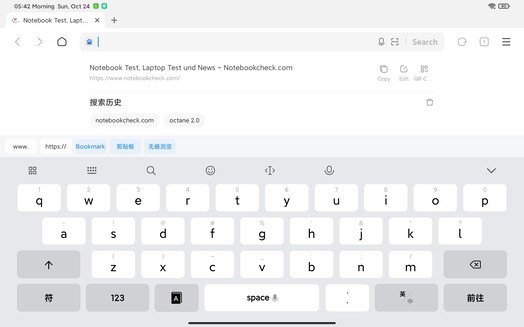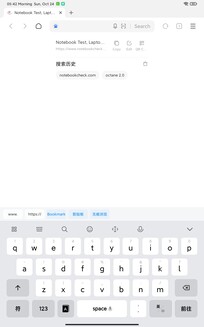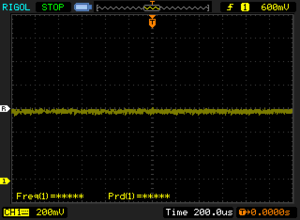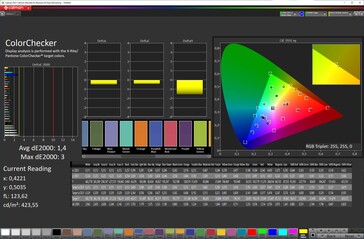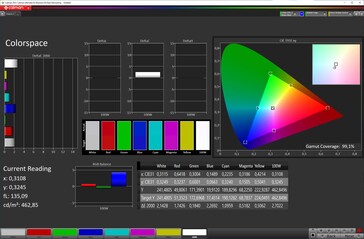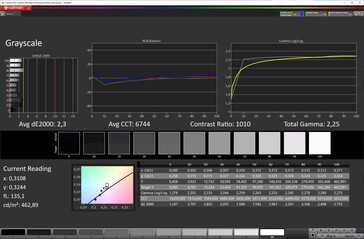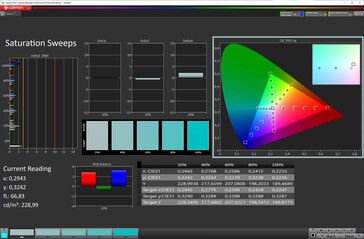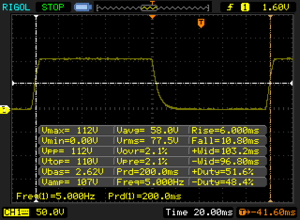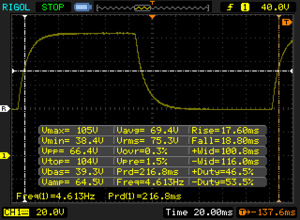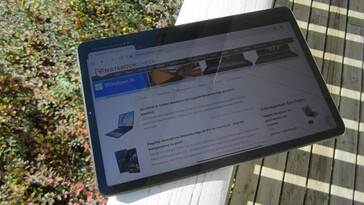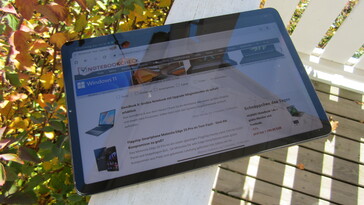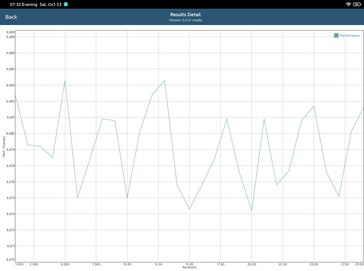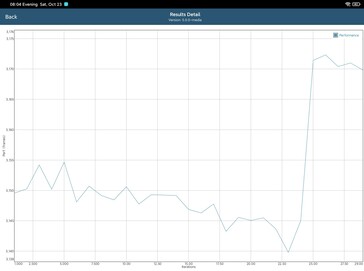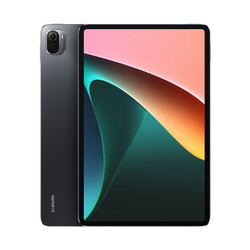Xiaomi Pad 5 Pro Tablet review: Fast iPad competitor with 120 Hz
Compact tablets with a lot of power are mainly known from Apple. Xiaomi is now launching an alternative with the Pad 5 Pro that makes you sit up and take notice. The 11-inch tablet is powered by the Snapdragon 870 which is currently one of the fastest mobile SoCs. This practically rules out performance bottlenecks.
In terms of price, the Xiaomi undercuts similarly designed Apple tablets like the Apple iPad Air 4 significantly. The Pad 5 Pro with 6 GB RAM, 128 GB storage and WiFi connectivity is available for around 430 Euros (~$489). For comparison: The iPad Air 4 costs around 550 Euros (~$625) in the smallest variant. But then you only get 64 GB of storage and have to live with a 60 Hz display. The IPS panel of the Pad 5 Pro offers 120 Hz.
Possible competitors in comparison
Rating | Date | Model | Weight | Height | Size | Resolution | Price |
|---|---|---|---|---|---|---|---|
| 88.7 % v7 (old) | 11 / 2021 | Xiaomi Pad 5 Pro SD 870, Adreno 650 | 515 g | 6.85 mm | 11.00" | 2560x1600 | |
| 90.7 % v7 (old) | 11 / 2020 | Apple iPad Air 4 2020 A14, A14 Bionic GPU | 458 g | 6.1 mm | 10.90" | 2360x1640 | |
| 88.4 % v7 (old) | 09 / 2021 | Huawei MatePad 11 2021 SD 865, Adreno 650 | 485 g | 7.25 mm | 10.95" | 2560x1600 | |
| 86.2 % v7 (old) | 04 / 2021 | Lenovo Tab P11 Pro SD 730G, Adreno 618 | 485 g | 5.8 mm | 11.50" | 2560x1600 | |
| 90.1 % v7 (old) | 10 / 2020 | Samsung Galaxy Tab S7 SD 865+ (Plus), Adreno 650 | 500 g | 6.3 mm | 11.00" | 2560x1600 |
Case - Apple iPad Air as a design template
Narrow display edges and rounded corners: The design of the Xiaomi Pad 5 Pro is clearly based on competitors like the current Apple iPad Air 4. It is similarly light at 550 grams (~19.4 oz) and almost as slim at 6.85 millimeters (~0.27 in). The Californians also serve as a model for the build quality.
The Xiaomi Pad 5 Pro relies on a sturdy aluminum frame and a matte back cover with a silky surface finish, which makes it look and feel high-end. The same applies for the physical keys that are arranged around the corner. The power button, which also integrates the fingerprint sensor, and the volume rocker sit firmly in the chassis and please with their crisp pressure point. However, the low price requires compromises: Gorilla Glass does not protect the panel and the back is only made of plastic. The Xiaomi also lacks an IP rating.
The 13 MP camera integrated in the upper left of the back cover seen from the display side only protrudes about 2 millimeters from the casing. Therefore, the tablet practically does not wobble back and forth on the table. However, you can provoke a slight rocking when you tap on the lower left or upper right corner of the display. The speakers are distributed over the two short sides. There is a magnetic dock for the optional keyboard cover on the bottom.
The Pad 5 Pro is available in black, white and green.
Features - The Pad 5 Pro is currently only available as an import
The Xiaomi Pad 5 Pro costs around 430 Euros (~$489) in the WiFi version with 6 GB LPDDR4x RAM and 128 GB UFS 3.1 storage. With 256 GB of storage, it is 470 Euros (~$534). The 5G version has 8/256 GB of storage and is about 100 Euros (~$114) more expensive. The storage cannot be expanded due to the lack of a microSD slot. The 5G version has a 50 MP camera, whereas the Wi-Fi version only has a 13 MP camera.
The Pad 5 Pro is currently not intended for the European market. However, if you want to buy it, you will find it at import specialists like our lender TradingShenzhen. We asked Xiaomi if and when the tablet will also be available in this country and will hopefully be able to provide the answer soon.
The Pad 5 should not be confused with the Pad 5 Pro. The Pad 5, which is only available as a Wi-Fi version, shares some features with the Pad 5 Pro, including the 120 Hz display and the storage configuration. With the Snapdragon 860 a slower SoC is used in the Pad 5. Charging is also limited to 33 watts and the casing only has 4 speakers. The Snapdragon 870, 67-watt charging, 8 speakers and a fingerprint sensor are only available in the Pad 5 Pro.
The USB-C port of the Pad 5 Pro works with USB 2.0 speed and also serves as an audio port due to the lack of a 3.5 mm jack. However, a suitable adapter is included in the scope of delivery. The tablet supports DRM Widevine L1 and can thus also play back streams in HD quality.
Software - Android 11 in English
The Xiaomi Pad 5 Pro runs Android 11 together with Xiaomi's user interface MIUI in the current version 12.5. At the time of testing (end of October), the Android security updates were as of July 1 and thus already somewhat outdated.
Since the Pad 5 Pro is currently only available via import, the tablet only runs the English/Chinese ROM. Google Play is also not installed. However, neither of these is a problem.
Apart from the fact that the tablet does not understand German, it can be used just like any other Xiaomi mobile device: MIUI 12.5 remains an intuitive user interface even in English. And Google Play can be installed quickly and easily via an APK file because all other services required for Google Play are already running on the Pad 5 Pro.
Communication and GNSS - Fast WiFi 6 in the Pad 5 Pro
The Pad 5 Pro supports Bluetooth 5.2, but not NFC. It communicates with Wi-Fi 6, which is also the speed of the stable transfer rates that we determined with our reference router Netgear Nighthawk AX12.
When it comes to transmission speed, only the Huawei MatePad 11 is still a bit faster, while the Samsung Galaxy Tab S7 is just ahead of the Xiaomi on the receiving side. The Apple iPad Air 4 clearly falls behind the Pad 5 Pro.
| Networking | |
| iperf3 transmit AX12 | |
| Huawei MatePad 11 2021 | |
| Xiaomi Pad 5 Pro | |
| Samsung Galaxy Tab S7 | |
| Apple iPad Air 4 2020 | |
| Lenovo Tab P11 Pro | |
| iperf3 receive AX12 | |
| Samsung Galaxy Tab S7 | |
| Xiaomi Pad 5 Pro | |
| Huawei MatePad 11 2021 | |
| Lenovo Tab P11 Pro | |
| Apple iPad Air 4 2020 | |
The Pad 5 Pro uses GPS (L1), GLONASS (L1), Galileo (E1) and BeiDou (B1) to determine the location. The tablet did not manage to capture usable satellite signals indoors in the test. Outdoors, it does more, but it takes half a minute until we get position information. They are at least accurate to 6 meters (~19.7 feet).
The tablet performs better in motion. The Pad 5 Pro records a 10-kilometer (~6.2 mi) bike tour with similar accuracy as the professional navigation device Garmin Edge 500.
Cameras - Solid 13 MP camera
Cameras are rather neglected in many tablets. However, Xiaomi's Pad 5 Pro does a pretty good job, even though it cannot compete with the Apple iPad in terms of image quality. The 8 MP selfie camera starts with a solid picture quality and records videos in 1080p at up to 30 frames per second. It automatically blurs the background in portrait mode.
If the lighting conditions are right, as in the sample pictures 1 and 2, the 13 MP main camera (f/2.0, AF) shoots decent photos that reproduce colors naturally and still show many image details. This is quite sufficient for occasional snapshots. Zoom shots are still acceptable as long as you do not enlarge the pictures too much. The camera capitulates in low-light conditions and then only produces blurry photos. The 13 MP camera records videos in acceptable quality and with up to 4K at 30 frames per second.
The difference to many smartphones is noticeable in the camera software, because the Pad 5 Pro only offers a few picture modes, which are more or less limited to photo, portrait and night scene. Thus, the tablet also lacks a Pro mode for manually adjusting the shooting parameters. However, basic features like flash, HDR, and various filters can be added, as well as an AI mode for automatic image optimization.
Image comparison
Choose a scene and navigate within the first image. One click changes the position on touchscreens. One click on the zoomed-in image opens the original in a new window. The first image shows the scaled photograph of the test device.
Daylight scene 1Daylight scene 25x ZoomLow light exposureWe took another look at the 13 MP main camera in the photo lab. Under optimal lighting conditions (upper color chart), it reproduces colors relatively accurately, but does not always hit darker hues exactly. At a brightness of 1 lux (lower color chart), the photographed colors and the original colors hardly have anything in common. The otherwise quite sharp test chart is then practically unrecognizable even with a lot of goodwill.
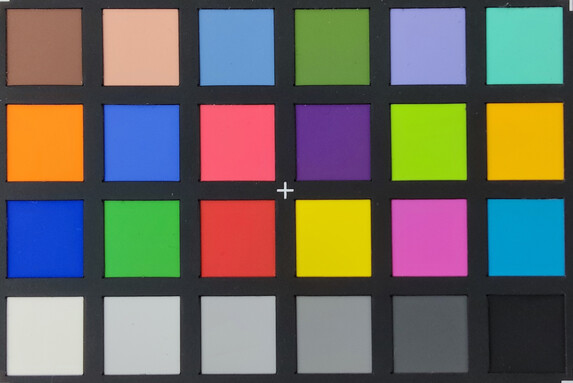

Accessories and warranty - 67-watt power supply costs extra
Xiaomi includes a 3.5 mm jack adapter for the USB-C port as well as a quick-start guide with the Pad 5 Pro, but we cannot use it due to our lack of knowledge of Chinese.
The 67-watt power supply is thus not part of the scope of delivery. However, our loaner TradingShenzen offers it just as as well as other accessories for the Pad 5 Pro, including the magnetically docking keyboard cover, a flip cover, and a Xiaomi stylus pen.
Xiaomi offers a 12-month warranty for its mobile devices. Beyond that, the warranty of the respective store or importer naturally applies.
Input devices & operation - 120 Hz display and fingerprint sensor
The 120 Hz display of the Xiaomi Pad 5 Pro, together with the eight-core SoC Snapdragon 870 and 6 GB of RAM ensure smooth operation throughout. Users are only slightly slowed down by the preinstalled keyboard.
Since the Pad 5 Pro is currently not available in Europe, you have to use the "iFlytek IME for MIUI" keyboard ex-factory, which is optimized for Chinese users. However, a standard keyboard like Google Gboard can be easily installed via Google Play. It is also a good idea to retire the Mi Browser and replace it with alternatives like Chrome or Firefox.
Unlike the Xiaomi Pad 5, the Pad 5 Pro has a fingerprint sensor integrated into the power button that works quickly and reliably. The second, but less secure biometric authentication method is the face scan. If there is enough ambient light and/or the screen is bright enough, unlocking the tablet via Face Unlock also works smoothly.
Display - IPS panel with HDR10 and Dolby Vision
The IPS display of the Xiaomi Pad 5 Pro has a resolution of 2560 x 1600 pixels. The refresh rate can be set to 60 or 120 Hz. The touch sampling rate is 240 Hz. Good: We did not notice PWM flickering.
Besides pen input, the display also supports HDR10 and Dolby Vision, which should please movie fans. However, the panel's brightness is not high enough to display HDR appealingly
With an average brightness of 475.4 cd/m² and a maximum of 497 cd/m², the panel almost exactly meets the manufacturer's luminance specification of 500 nits. If you repeat the measurement with evenly distributed bright dark areas (APL50) instead of a pure white background, you can achieve up to 477 cd/m². We measured 1.22 cd/m² in the lowest brightness setting.
| |||||||||||||||||||||||||
Brightness Distribution: 89 %
Center on Battery: 497 cd/m²
Contrast: 1183:1 (Black: 0.42 cd/m²)
ΔE ColorChecker Calman: 1.4 | ∀{0.5-29.43 Ø4.79}
ΔE Greyscale Calman: 2.3 | ∀{0.09-98 Ø5}
99.1% sRGB (Calman 2D)
Gamma: 2.25
CCT: 6744 K
| Xiaomi Pad 5 Pro IPS, 2560x1600, 11" | Apple iPad Air 4 2020 IPS, 2360x1640, 10.9" | Huawei MatePad 11 2021 IPS, 2560x1600, 11" | Lenovo Tab P11 Pro OLED, 2560x1600, 11.5" | Samsung Galaxy Tab S7 LTPS, 2560x1600, 11" | |
|---|---|---|---|---|---|
| Screen | 5% | -72% | -22% | -9% | |
| Brightness middle (cd/m²) | 497 | 509 2% | 550 11% | 372 -25% | 554 11% |
| Brightness (cd/m²) | 475 | 486 2% | 515 8% | 375 -21% | 535 13% |
| Brightness Distribution (%) | 89 | 93 4% | 90 1% | 95 7% | 91 2% |
| Black Level * (cd/m²) | 0.42 | 0.39 7% | 0.96 -129% | 0.33 21% | |
| Contrast (:1) | 1183 | 1305 10% | 573 -52% | 1679 42% | |
| Colorchecker dE 2000 * | 1.4 | 1.3 7% | 3.3 -136% | 1.8 -29% | 2.1 -50% |
| Colorchecker dE 2000 max. * | 3 | 2.8 7% | 7.9 -163% | 4.2 -40% | 7.1 -137% |
| Greyscale dE 2000 * | 2.3 | 2.2 4% | 4.9 -113% | 2.8 -22% | 1.6 30% |
| Gamma | 2.25 98% | 2.21 100% | 2.24 98% | 2.29 96% | 2.32 95% |
| CCT | 6744 96% | 6833 95% | 7288 89% | 6718 97% | 6623 98% |
| Color Space (Percent of AdobeRGB 1998) (%) | 99.3 |
* ... smaller is better
Screen Flickering / PWM (Pulse-Width Modulation)
| Screen flickering / PWM not detected | |||
In comparison: 53 % of all tested devices do not use PWM to dim the display. If PWM was detected, an average of 8156 (minimum: 5 - maximum: 343500) Hz was measured. | |||
The Pad 5 Pro offers 3 color profiles. "Vivid" is preset, others are "Saturated" and "Standard". In addition, the color temperature can be changed via the color wheel or via 4 settings. If you activate the "Adaptive Colors" button, the tablet adjusts the display colors to the ambient light.
We get the best color representation in the color profile "Standard" and a color temperature set to "Default". Colors and grayscale are then so accurate with a Delta E value of well below 3 that you cannot see any difference between the displayed color and the original color with the naked eye.
Display Response Times
| ↔ Response Time Black to White | ||
|---|---|---|
| 16.8 ms ... rise ↗ and fall ↘ combined | ↗ 6 ms rise | |
| ↘ 10.8 ms fall | ||
| The screen shows good response rates in our tests, but may be too slow for competitive gamers. In comparison, all tested devices range from 0.1 (minimum) to 240 (maximum) ms. » 37 % of all devices are better. This means that the measured response time is better than the average of all tested devices (20.3 ms). | ||
| ↔ Response Time 50% Grey to 80% Grey | ||
| 36.4 ms ... rise ↗ and fall ↘ combined | ↗ 17.6 ms rise | |
| ↘ 18.8 ms fall | ||
| The screen shows slow response rates in our tests and will be unsatisfactory for gamers. In comparison, all tested devices range from 0.165 (minimum) to 636 (maximum) ms. » 51 % of all devices are better. This means that the measured response time is worse than the average of all tested devices (31.7 ms). | ||
Performance - The Pad 5 Pro is one of the fastest Android tablets
Equipped with the Snapdragon 870 and its upper-class GPU Adreno 650 the Xiaomi Pad 5 Pro is currently one of the fastest Android tablets. Results like just over 700000 points in AnTuTu v9 (AnTuTu v8 unfortunately crashes) and a multi-core score of 3317 points in Geekbench speak for themselves.
In the synthetic benchmarks and the browser performance, the Xiaomi tablet only has to contend with the Apple iPad Air 4 among the comparison devices. On the Android side, the Samsung Galaxy Tab S7 is always close behind with its Snapdragon 865+.
| PCMark for Android | |
| Work 3.0 | |
| Average Qualcomm Snapdragon 870 5G (9827 - 16054, n=15) | |
| Average of class Tablet (3195 - 27428, n=84, last 2 years) | |
| Xiaomi Pad 5 Pro | |
| Huawei MatePad 11 2021 | |
| Work 2.0 performance score | |
| Samsung Galaxy Tab S7 | |
| Average Qualcomm Snapdragon 870 5G (10060 - 14315, n=5) | |
| Xiaomi Pad 5 Pro | |
| Lenovo Tab P11 Pro | |
| AnTuTu v8 - Total Score | |
| Apple iPad Air 4 2020 | |
| Average Qualcomm Snapdragon 870 5G (573296 - 595585, n=3) | |
| Samsung Galaxy Tab S7 | |
| Huawei MatePad 11 2021 | |
| Lenovo Tab P11 Pro | |
| Xiaomi Pad 5 Pro | |
| AImark - Score v2.x | |
| Huawei MatePad 11 2021 | |
| Xiaomi Pad 5 Pro | |
| Average Qualcomm Snapdragon 870 5G (111838 - 123847, n=9) | |
| Lenovo Tab P11 Pro | |
| Apple iPad Air 4 2020 | |
| Jetstream 2 - 2.0 Total Score | |
| Apple iPad Air 4 2020 (Safari Mobile 14) | |
| Average of class Tablet (22.3 - 395, n=71, last 2 years) | |
| Average Qualcomm Snapdragon 870 5G (60.7 - 108.3, n=12) | |
| Xiaomi Pad 5 Pro (Chrome 94.0.4606.85) | |
| Samsung Galaxy Tab S7 (Chrome86) | |
| Huawei MatePad 11 2021 (Huawei Browser 11.1) | |
| Lenovo Tab P11 Pro (Chrome 89.0.4389.105) | |
| JetStream 1.1 - Total Score | |
| Apple iPad Air 4 2020 (Safari Mobile 14) | |
| Average Qualcomm Snapdragon 870 5G (105.1 - 184.5, n=9) | |
| Xiaomi Pad 5 Pro (Chrome 94.0.4606.85) | |
| Samsung Galaxy Tab S7 (Chrome86) | |
| Huawei MatePad 11 2021 (Huawei Browser 11.1) | |
| Lenovo Tab P11 Pro (Chrome 89.0.4389.105) | |
| WebXPRT 3 - Overall | |
| Average of class Tablet (39 - 480, n=27, last 2 years) | |
| Apple iPad Air 4 2020 (Safari Mobile 14) | |
| Average Qualcomm Snapdragon 870 5G (94 - 155, n=13) | |
| Xiaomi Pad 5 Pro (Chrome 94.0.4606.85) | |
| Samsung Galaxy Tab S7 (Chrome86) | |
| Huawei MatePad 11 2021 (Huawei Browser 11.1) | |
| Lenovo Tab P11 Pro (Chrome 89.0.4389.105) | |
| Speedometer 2.0 - Result 2.0 | |
| Apple iPad Air 4 2020 (Safari Mobile 14) | |
| Average of class Tablet (2.59 - 790, n=60, last 2 years) | |
| Samsung Galaxy Tab S7 (Chrome86) | |
| Xiaomi Pad 5 Pro (Chrome 94.0.4606.85) | |
| Average Qualcomm Snapdragon 870 5G (51.4 - 77, n=12) | |
| Huawei MatePad 11 2021 (Huawei Browser 11.1) | |
| Lenovo Tab P11 Pro (Chrome 89.0.4389.105) | |
| Octane V2 - Total Score | |
| Apple iPad Air 4 2020 (Safari Mobile 14) | |
| Average of class Tablet (763 - 138481, n=102, last 2 years) | |
| Average Qualcomm Snapdragon 870 5G (20543 - 41256, n=13) | |
| Xiaomi Pad 5 Pro (Chrome 94.0.4606.85) | |
| Samsung Galaxy Tab S7 (Chrome86) | |
| Huawei MatePad 11 2021 (Huawei Browser 11.1) | |
| Lenovo Tab P11 Pro (Chrome 89.0.4389.105) | |
| Mozilla Kraken 1.1 - Total | |
| Lenovo Tab P11 Pro (Chrome 89.0.4389.105) | |
| Average of class Tablet (243 - 27101, n=84, last 2 years) | |
| Huawei MatePad 11 2021 (Huawei Browser 11.1) | |
| Samsung Galaxy Tab S7 (Chrome86) | |
| Xiaomi Pad 5 Pro (Chrome 94.0.4606.85) | |
| Average Qualcomm Snapdragon 870 5G (1055 - 1792, n=13) | |
| Apple iPad Air 4 2020 (Safari Mobile 14) | |
* ... smaller is better
The Pad 5 Pro's UFS 3.1 memory ensures short load times with a high sequential read rate. The 4K random reads/writes are also above average.
| Xiaomi Pad 5 Pro | Huawei MatePad 11 2021 | Lenovo Tab P11 Pro | Samsung Galaxy Tab S7 | Average 128 GB UFS 3.1 Flash | Average of class Tablet | |
|---|---|---|---|---|---|---|
| AndroBench 3-5 | -20% | -64% | -18% | -9% | 9% | |
| Sequential Read 256KB (MB/s) | 1684 | 1468 -13% | 486.8 -71% | 1512 -10% | 1586 ? -6% | 1663 ? -1% |
| Sequential Write 256KB (MB/s) | 772 | 708 -8% | 192.3 -75% | 680 -12% | 763 ? -1% | 1216 ? 58% |
| Random Read 4KB (MB/s) | 289.3 | 190.7 -34% | 136.3 -53% | 219 -24% | 243 ? -16% | 236 ? -18% |
| Random Write 4KB (MB/s) | 281.5 | 217.5 -23% | 123.3 -56% | 211.5 -25% | 241 ? -14% | 268 ? -5% |
Games - Run smoothly, but 120 FPS remain the exception
Through its Snapdragon 870-SoC, the Xiaomi Pad 5 Pro has more than enough power to run every current game smoothly. The 8 speakers provide a strong background sound.
Theoretically, you do not have to compromise on detail level and frame rate in view of the SoC power. At least in our two test games, Armajet and PUBG Mobile, the Pad 5 Pro cannot take advantage of its 120 Hz screen. Both games are limited to 30 frames per second.
We determined the frame rates with the tool Gamebench.
Emissions - 8 speakers with Dolby Atmos
Temperature
The Pad 5 Pro gets warm to the touch during operation. We measured a maximum of 35.4 °C (~96 °F) on the surface after one hour of stress testing. Internally, the tablet also has its temperatures under control, as the stress tests with GFXBench and 3DMark show. Thus, the tablet can fully utilize its performance at any time.
3DMark Wild Life Stress Test
(+) The maximum temperature on the upper side is 35.4 °C / 96 F, compared to the average of 33.7 °C / 93 F, ranging from 20.7 to 53.2 °C for the class Tablet.
(+) The bottom heats up to a maximum of 34.4 °C / 94 F, compared to the average of 33.2 °C / 92 F
(+) In idle usage, the average temperature for the upper side is 31.2 °C / 88 F, compared to the device average of 30 °C / 86 F.
Speaker
When it comes to audio, the Pad 5 Pro brings out the big guns. There are 8 speakers with Dolby Atmos support in the tablet, 4 more than in the sister model Pad 5 (without Pro). Four Dolby Atmos presets for optimal sound can be selected in the settings with Dynamic, Video, Music and Voice.
That reads impressive on paper, but does not sound quite as spectacular in practice. No matter which preset we select, basses are much more present compared to typical smartphone speakers, but still somewhat underrepresented in the sound mix, while mids are given too much space. The tablet only presents the high tones very balanced. Overall, the speakers deliver a solid stereo sound.
Headsets and external speakers can be connected to the Pad 5 Pro via the included 3.5 mm jack adapter. This works wirelessly via Bluetooth 5.2.
Xiaomi Pad 5 Pro audio analysis
(+) | speakers can play relatively loud (85.9 dB)
Bass 100 - 315 Hz
(±) | reduced bass - on average 12.6% lower than median
(±) | linearity of bass is average (8.4% delta to prev. frequency)
Mids 400 - 2000 Hz
(+) | balanced mids - only 4.7% away from median
(+) | mids are linear (4.8% delta to prev. frequency)
Highs 2 - 16 kHz
(+) | balanced highs - only 4.1% away from median
(±) | linearity of highs is average (7.3% delta to prev. frequency)
Overall 100 - 16.000 Hz
(+) | overall sound is linear (12.4% difference to median)
Compared to same class
» 19% of all tested devices in this class were better, 5% similar, 76% worse
» The best had a delta of 7%, average was 21%, worst was 129%
Compared to all devices tested
» 10% of all tested devices were better, 2% similar, 88% worse
» The best had a delta of 4%, average was 24%, worst was 134%
Apple iPad Air 4 2020 audio analysis
(+) | speakers can play relatively loud (86.3 dB)
Bass 100 - 315 Hz
(±) | reduced bass - on average 14.2% lower than median
(±) | linearity of bass is average (12.2% delta to prev. frequency)
Mids 400 - 2000 Hz
(+) | balanced mids - only 3.8% away from median
(+) | mids are linear (3.8% delta to prev. frequency)
Highs 2 - 16 kHz
(±) | higher highs - on average 5.3% higher than median
(+) | highs are linear (4.9% delta to prev. frequency)
Overall 100 - 16.000 Hz
(+) | overall sound is linear (12.9% difference to median)
Compared to same class
» 22% of all tested devices in this class were better, 4% similar, 74% worse
» The best had a delta of 7%, average was 21%, worst was 129%
Compared to all devices tested
» 12% of all tested devices were better, 3% similar, 86% worse
» The best had a delta of 4%, average was 24%, worst was 134%
Power management - Fully charged in 72 minutes
Energy consumption
The Pad 5 Pro consumes considerably less power than the comparison devices in some cases. Only the Lenovo Tab P11 Pro is even more energy-efficient than the Xiaomi under load. However, the Pad 5 Pro remains unbeaten in the other load scenarios.
The 8600 mAh battery can be charged very quickly with the optional 67-watt power supply. It only takes 1:12 hours to bring the empty battery back to 100% in the test. The Apple iPad Air 4 needs twice as long. 80% fill level is already reached after 50 minutes.
| Off / Standby | |
| Idle | |
| Load |
|
Key:
min: | |
| Xiaomi Pad 5 Pro 8600 mAh | Apple iPad Air 4 2020 mAh | Huawei MatePad 11 2021 7250 mAh | Lenovo Tab P11 Pro 8600 mAh | Samsung Galaxy Tab S7 8000 mAh | |
|---|---|---|---|---|---|
| Power Consumption | -40% | -10% | 3% | -6% | |
| Idle Minimum * (Watt) | 1.14 | 1.3 -14% | 1.33 -17% | 1.55 -36% | 1.16 -2% |
| Idle Average * (Watt) | 4.3 | 7.89 -83% | 5.37 -25% | 4.91 -14% | 4.42 -3% |
| Idle Maximum * (Watt) | 4.31 | 7.91 -84% | 5.41 -26% | 5.02 -16% | 4.43 -3% |
| Load Average * (Watt) | 8.09 | 9.28 -15% | 6.87 15% | 4.38 46% | 8.86 -10% |
| Load Maximum * (Watt) | 10.32 | 10.78 -4% | 10.08 2% | 6.81 34% | 11.6 -12% |
* ... smaller is better
Power consumption: Geekbench (150 cd/m²)
Power consumption: GFXBench (150 cd/m²)
Battery life
Its large battery helps the Pad 5 Pro achieve above-average runtimes. And that is also enough to keep the assembled tablet competition at bay.
With over 15 hours of simulated web surfing and almost 17 hours of continuous video playback, Xiaomi's tablet is the best among the comparison devices. Together with the short charging time, the Pad 5 Pro can be used very flexibly in everyday use.
| Xiaomi Pad 5 Pro 8600 mAh | Apple iPad Air 4 2020 mAh | Huawei MatePad 11 2021 7250 mAh | Lenovo Tab P11 Pro 8600 mAh | Samsung Galaxy Tab S7 8000 mAh | |
|---|---|---|---|---|---|
| Battery runtime | -10% | -17% | -14% | -18% | |
| Reader / Idle (h) | 50.2 | 34 -32% | 32.9 -34% | 27.4 -45% | 32.7 -35% |
| H.264 (h) | 16.8 | 11.2 -33% | 14.4 -14% | 14.2 -15% | 14.8 -12% |
| WiFi v1.3 (h) | 15.4 | 11.7 -24% | 13.9 -10% | 10.4 -32% | 13.5 -12% |
| Load (h) | 4.3 | 6.5 51% | 3.9 -9% | 5.8 35% | 3.7 -14% |
Pros
Cons
Conclusion about the Xiaomi Pad 5 Pro
Xiaomi has launched a strong 11-inch tablet with the Pad 5 Pro. Not only can it compete with the Apple iPad in terms of looks, but also in terms of performance. Equipped with the Snapdragon 870, the Adreno 650 graphics accelerator and 6 GB RAM, it is currently one of the fastest Android tablets.
Further arguments for the Pad 5 Pro are its bright IPS screen with 120 Hz, which allows Xiaomi to achieve a refresh rate twice as high as the Apple iPad Air 4. However, the Xiaomi does not come close to the Apple model in terms of cameras, but it does a pretty good job. The battery runtimes and the option to quickly charge the tablet via a 67-watt power adapter are again very strong.
Strong performance, bright 120 Hz display, long battery runtimes and, on top of that, good value for money: If you are looking for a handy and powerful Android tablet and do not want to pay Apple prices for it, the Xiaomi Pad 5 Pro is a good choice.
The Pad 5 Pro is currently only available via import. Android 11 and MIUI 12.5 are therefore only available in English. However, Google Play can be installed immediately, so the user experience is not really inferior to that of a standard MIUI.
However, it is not without compromises in view of the low price. The Pad 5 Pro lacks IP certification and a screen protector. However, an unspecified "scratch- and shatter-proof" display glass is used. Instead of a metal or glass chassis, you have to live with a chicly designed but plastic back cover. An OLED screen is also not included. The scope of delivery is practically limited to a 3.5 mm jack adapter for the USB-C port. The power adapter is just as optional as the stylus and the docking keyboard.
Xiaomi itself offers an alternative to the Pad 5 Pro: the Pad 5. The "non-Pro" variant relies on the Snapdragon 860 instead of the Snapdragon 870, sounds from 4 instead of 8 speakers, comes without a fingerprint sensor and can only be charged with a maximum of 33 watts. However, it can be purchased officially and some buyers already pay less than 400 Euros (~$454) for the small storage version with 6/128 GB.
Price and availability
The Xiaomi Pad 5 Pro is currently only available via import retailers like our loaner TradingShenzhen. It currently costs around €430 (~$489) with 6/128 GB storage, and around €470 (~$534) with 256 GB storage. The 5G version with 8/256 GB costs €540 (~$613).
Xiaomi Pad 5 Pro
- 10/29/2021 v7 (old)
Manuel Masiero




